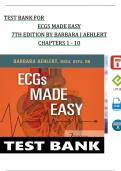Exam (elaborations)
TEST BANK For ECGs Made Easy 7th Edition by Barbara J Aehlert, All Chapters 1 - 10, Verified Newest Version
- Course
- Institution
- Book
TEST BANK For ECGs Made Easy 7th Edition by Barbara J Aehlert, All Chapters 1 - 10, Verified Newest Version TEST BANK For ECGs Made Easy 7th Edition by Barbara J Aehlert, All Chapters 1 - 10, Verified Newest Version TEST BANK For ECGs Made Easy 7th Edition by Barbara J Aehlert, All Chapters 1 - 10,...
[Show more]



